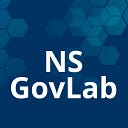Two weeks ago, the CoCreation team planned a second prototyping session for fellows to make adaptations to their prototype or anything else that would assist their testing with end users over the next two weeks (check out our blog post on prototyping session two).
The initial phase of NS GovLab has been a continuous and infinite phase of learning, building and testing. The learning journey session gave fellows the opportunity to reflect and share the learnings they had over the past few months that got them to where they are now.
There were five steps in the learning journey day:
Step One: Check-in
Once everyone arrived and settled in, everyone came together to talk about the theme for the day.
Over the past few months, fellows have been learning about social innovation, human-centered design, research synthesis, and prototyping but today’s learning journey day was taking a different approach.
This session would be looking at the current systems from a higher level to see the effects it has. The previous sessions were a lower level that had a direct focus on learning and prototyping. Fellows were encouraged to think about their learnings from NS GovLab at an individual, team, and societal level throughout the day.
Step Two: Re-group and share-back
After check-in with everyone, fellows sat with their teams to speak about what their work over the past two weeks.
Many groups had come to realizations that they may want to take a step back and test something smaller, redefine their How Might We question, or conclude that they were focused on the solution rather than the problem.
There has been a heavy emphasis on falling in love with the problem rather than the solution during the past few months with NS GovLab. By heavily focusing on the solution, you may lose sight of the problem you are trying to solve.
The teams were given time to continue working on their prototype to take out for testing following the learning journey session.
After time to work on their prototype, everyone came back to share where their team is at now. They all agreed that they were making a shift before going out to test again.
Step Three: Individual and Paired Reflection
The CoCreation team provided time for the fellows to think about their learnings over the past few months guided by three questions:
1. What have you learned?
2. What has been challenging?
3. Are there any AHA! moments thus far?
Fellows took these questions and found a space to reflect outside or in a private space.
After individual reflection, fellows were randomly paired to share their learnings and have someone listen. Based off the individual reflection questions, fellows were to create a 15 second (32 word) description of their learnings, challenges, AHA moments, or any other significant information that has shaped their experience with NS GovLab.
After half an hour, everyone came back to share their 15 second description of learnings.
Step Four: Systems mapping
Following lunch, the fellows and CoCreation team created a systems map. The systems map was made with objects built out of paper, lego, play-doh, and other materials that would represent the key actors and places that effect the systems of aging in Nova Scotia.
Each group took 30 minutes to think about the key actors and places they have interacted with through their design questions, research synthesis, and prototyping. Systems mapping provided fellows the opportunity to reveal what they have learned about the current systems in place with regard to aging in Nova Scotia.
The teams and the CoCreation team came around a table to map out the current system to reveal how they interact. (Stay tuned for a video to come on the systems map the fellows and CoCreation team built during the learning journey session)
Some of the common objects from the teams included:
1. Funding, banks, investors
2. Formal and informal care
3. Schools, libraries, academia, research
4. 211
5. Community services
6. Isolated seniors
A fellow had important insights, “strong children are built by strong families and strong families are built by strong communities. The community is the strength and the community has to be intergenerational.”
Step Five: End of day
After systems mapping, everyone came together to close the day. Everyone had a full day of reflecting their learnings over the past few months and how their thinking has shifted over time.
The teams were given homework to do a Pecha Kucha that is a slideshow made of 20 slides and only pictures on the slides. Each picture will represent the fellows learnings and each slide only has 20 seconds to be explained.
The fellows and CoCreation team will meet up in week to share their learnings, get feedback and comments, and think about where they want to go during the 8 month integration phase of the fellowship.
Keep up-to-date with NS GovLab on Medium and on Twitter (@NSGovLab).
